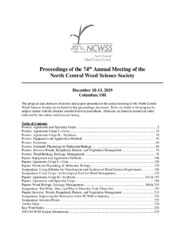Prikaz osnovnih podataka o dokumentu
Growth and Sensitivity of Dicamba-Tolerant Soybean to Micro-Rates of 2,4-D
| dc.creator | Knežević, Stevan | |
| dc.creator | Scott, John | |
| dc.creator | Jovanović, Darko | |
| dc.creator | Cuvaca, Ivan | |
| dc.date.accessioned | 2024-02-22T11:01:42Z | |
| dc.date.available | 2024-02-22T11:01:42Z | |
| dc.date.issued | 2019 | |
| dc.identifier.isbn | 9781713803362 | |
| dc.identifier.uri | http://RIVeC.institut-palanka.rs/handle/123456789/827 | |
| dc.description.abstract | 2,4-D is prone to drift. This raises a concern regarding potential damage to non 2,4-D-tolerant soybean. The objective of this study was to investigate the impact of 2,4-D micro-rates on growth and sensitivity of dicamba-tolerant (DT) soybean. A randomized complete block design with a split-plot arrangement and eight replications was used. Main plots consisted of three 2,4-D application times [second trifoliate (V2); beginning of flowering (V7/R1); and full flowering (R2)] and subplots consisted of six micro rates of 2,4-D (1/5; 1/10; 1/50; 1/100; 1/500; and 1/1000 of the label recommended dose of 1,120 g ae ha-1) and a check with no herbicide applied. Visual injury assessment and plant height measurement were performed at 7, 14 and 21 days after treatment (DAT). Number of days to canopy closure was also recorded. Increase in 2,4-D dose increased soybean injury and reduced plant height regardless of application time. Soybean was 1.9- and 2.6-times more sensitive to 2,4-D injury at V2 and R2 stage, respectively, than the R1 stage; however, plant height reduction at the R1 stage was 4.4- and 2.6-fold that of the V2 and R2 stage, respectively. This reduction in plant height ultimately delayed canopy closure. For example, 0.89 g ae ha-1 of 2,4-D delayed canopy closure at R1 stage by 5 days and a 3.8 (3.40 g ae ha-1)- and 5.7 (5.09 g ae ha-1)-fold higher dose was required to delay canopy closure by same number of days (eg. 5 days) at the V2 and R2 stage, respectively. Leaf curling was more severe at both R1 and R2 than the V2 stage. Altogether, these results show that DT soybean is sensitive to micro-rates of 2,4-D especially at the onset of the reproductive stage (R1). Therefore, late 2,4-D applications should be avoided to prevent potential interference with pod formation and ultimately yield. | sr |
| dc.language.iso | en | sr |
| dc.publisher | North Central Weed Science Society (NCWSS) | sr |
| dc.rights | openAccess | sr |
| dc.source | Proceedings of the 74th Annual Meeting of the North Central Weed Science Society, December 10-13, 2019 Columbus, OH | sr |
| dc.subject | 2,4-D | sr |
| dc.subject | dicamba-tolerant (DT) soybean | sr |
| dc.title | Growth and Sensitivity of Dicamba-Tolerant Soybean to Micro-Rates of 2,4-D | sr |
| dc.type | conferenceObject | sr |
| dc.rights.license | ARR | sr |
| dc.citation.spage | 23 | |
| dc.citation.volume | 74 | |
| dc.identifier.fulltext | http://RIVeC.institut-palanka.rs/bitstream/id/2654/DJ01.pdf | |
| dc.identifier.rcub | https://hdl.handle.net/21.15107/rcub_rivec_827 | |
| dc.type.version | publishedVersion | sr |


